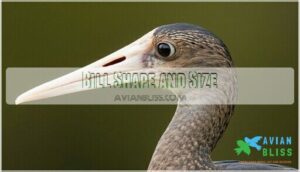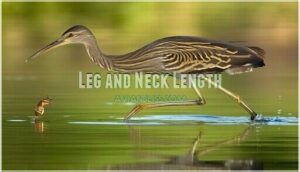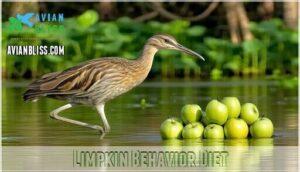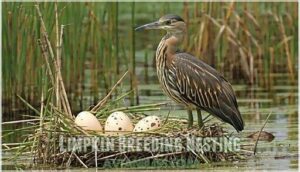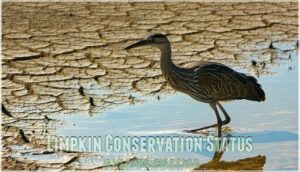This site is supported by our readers. We may earn a commission, at no cost to you, if you purchase through links.
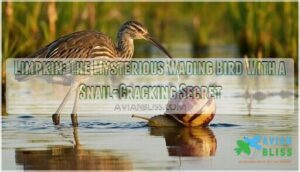
These two-foot-tall wading birds call Florida’s freshwater marshes home, where they’ve mastered the art of extracting apple snails from their shells with surgical precision.
Think of them as the wetlands’ ultimate specialists, living almost entirely on a snail-based diet that most birds can’t crack.
Their haunting calls echo through swamps at dawn, earning them the nickname "crying bird".
While they faced near-extinction in the early 1900s, conservation efforts and ironically, invasive apple snails, have helped their numbers bounce back remarkably.
Table Of Contents
- Key Takeaways
- Limpkin Physical Description
- Limpkin Habitat Distribution
- Limpkin Behavior Diet
- Limpkin Breeding Nesting
- Limpkin Conservation Status
- Frequently Asked Questions (FAQs)
- What does a limpkin look like?
- Where does a limpkin live?
- How did a limpkin get its name?
- Is a limpkin a boring bird?
- Where does a limpkin fly?
- Are limpkins obsolete?
- Why do Limpkins scream all night?
- How rare are Limpkins?
- Why is it called the Limpkin?
- What is the difference between a sandhill crane and a Limpkin?
- Conclusion
Key Takeaways
- You’ll instantly recognize a limpkin by its mottled brown plumage with white streaks and distinctive down-curved yellow bill that’s perfectly designed for extracting apple snails from their shells.
- You can find these specialized wading birds in Florida’s freshwater marshes, swamps, and lakeshores, where they’ve mastered living almost entirely on a snail-based diet that most other birds can’t crack.
- You’ll hear their haunting calls echoing through wetlands at dawn and dusk, earning them the nickname "crying bird" as they communicate while hunting nocturnally for their favorite prey.
- You’re witnessing a conservation success story—these birds bounced back from near-extinction in the early 1900s and now benefit from both habitat protection efforts and an unexpected boost from invasive apple snail populations.
Limpkin Physical Description
You’ll recognize a limpkin by its heron-sized brown body covered in white spots and streaks, standing 25 to 29 inches tall with a 40 to 42-inch wingspan.
This wading bird’s most distinctive feature is its long, yellow bill that curves slightly downward and to the right, perfectly designed for extracting snails from their shells, which is a key aspect of its behavior as a wading bird.
Nature’s perfect snail-shucking tool: a curved yellow bill that works like precision tweezers in the wetlands.
Length and Wingspan
You’ll find the Limpkin’s measurements quite impressive for a wading bird.
These medium-sized birds stretch 25-29 inches long with wingspans reaching 40-42 inches.
Size comparison puts them between night-herons and Great Egrets.
Their long wings provide excellent flight adaptations for covering wetland territories.
Subspecies variation shows minimal differences in overall measurements, though some populations appear slightly smaller than others.
These wings are covered in contour and flight feathers essential for lift and are a key aspect of their wetland territories.
Color and Plumage
Looking at a limpkin, you’ll notice its striking brown plumage adorned with distinctive white spots and streaks.
This bird color pattern creates a mottled appearance that’s unmistakable among wading birds.
The brown bird displays remarkable consistency across different regions, though subtle variations exist.
- Plumage Variations differ slightly between subspecies, with some showing darker brown tones
- Juvenile Markings appear less pronounced than adults, featuring fewer white streaks
- Underwing Coverts flash bright white during flight, contrasting beautifully with darker wing feathers
Bill Shape and Size
The limpkin’s bill is a remarkable tool perfectly designed for its snail-eating lifestyle.
Nature crafted the ultimate snail-cracking device right on the limpkin’s face.
You’ll notice the downcurved bill measures 4-5 inches long with a slight rightward curve.
This bill curvature creates a small gap near the tip when closed, functioning like precision tweezers.
These bill adaptations maximize feeding efficiency, allowing expert snail extraction from shells with minimal effort, making the limpkin’s bill a highly efficient tool for its snail-eating lifestyle, and utilizing its unique shape to extract snails with minimal effort.
Leg and Neck Length
Both the long neck and long legs serve as essential wading adaptations for this remarkable wetland bird.
You’ll notice these bird physical features stretch proportionally, giving limpkins impressive foraging reach in shallow waters.
Their extended limbs enable ideal probing depth while maintaining visual acuity above water.
These flight dynamics also help them navigate between feeding sites with graceful efficiency, and their overall structure allows for efficient movement.
Weight and Sex Differences
You won’t find obvious sexual dimorphism in limpkin plumage, but males tip the scales slightly heavier than females.
Weight variation spans 900 to 1,300 grams, with males averaging around 1,080 grams.
This size disparity helps during territorial disputes, though both sexes share identical brown-and-white streaked feathers.
Age differences and regional weight fluctuations also influence individual bird size variations.
Limpkin Habitat Distribution
You’ll find limpkins in freshwater swamps, marshes, and along the shores of ponds and lakes throughout Florida, the Caribbean, and Central America.
Their range depends entirely on where apple snails live, since these birds can’t survive without their favorite snail-based meals.
Freshwater Swamps and Marshes
You’ll discover limpkin birds thriving in Florida’s freshwater swamps and marshes, where these wetlands create perfect hunting grounds.
These specialized habitat areas support the bird’s unique lifestyle through:
- Shallow water zones ideal for wading and snail detection
- Dense vegetation providing nesting sites and protection
- Rich swamp ecology supporting diverse prey populations
- Stable water quality maintaining healthy apple snail colonies
- Protected marshes ensuring habitat conservation against climate impacts
The combination of these factors creates an environment that is essential for the survival of limpkin birds, allowing them to thrive in their native habitats.
Open Freshwater Marshes
Freshwater marshes serve as prime real estate for the limpkin bird, offering shallow waters perfect for wading and hunting.
These Florida bird habitats feature dense vegetation that provides cover while supporting healthy apple snail populations.
Water quality and marsh ecology directly impact limpkin success, as invasive species and climate change threaten traditional wetland systems through habitat management challenges.
Shores of Ponds and Lakes
You’ll spot limpkins along quiet pond edges and lake shores where apple snails thrive in shallow waters.
These birds prefer areas with healthy water quality and dense lakeside vegetation that supports snail populations.
Pond ecology creates perfect hunting grounds where limpkins can:
- Wade through calm shoreline waters
- Access abundant freshwater snail colonies
- Find protection from shoreline erosion, allowing them to thrive in areas with healthy water quality.
Wooded Swamps Along Rivers and Springs
You’ll find limpkins thriving in wooded swamps where rivers and springs create perfect conditions.
These forested wetlands offer ideal swamp ecology with excellent water quality that supports abundant apple snails.
The riverine habitats provide steady freshwater flow, while spring influence maintains consistent temperatures.
This wading bird loves these protected environments where tall trees create canopy cover over shallow waters, providing a unique setting that supports its lifestyle with abundant apple snails.
Tropical Range and Apple Snail Presence
Beyond Florida’s borders, you’ll encounter the Guarana subspecies (Aramus guarauna) stretching across the Caribbean, Central America, and South America east of the Andes.
This snail dependency drives their habitat specifics—wherever apple snails thrive, limpkins follow.
Regional variations show darker, smaller birds southward, with range expansion tied directly to apple snail populations throughout their tropical distribution.
These habitats are threatened, impacting tropical bird ecosystems, which is a critical issue for avian conservation and ecosystem balance.
Limpkin Behavior Diet
You’ll discover that limpkins are skilled hunters with a specialized diet built around apple snails, which they extract using their uniquely curved bills.
These adaptable birds also forage at night and will eat frogs, insects, and mussels when their favorite snails aren’t available, making them skilled hunters in various environments.
Solitary and Colonial Behavior
You’ll discover limpkins aren’t strictly loners.
These birds switch between solitary hunting and loose group foraging when apple snails are abundant.
During breeding season, territorial disputes intensify as males establish prime wetland real estate.
Their courtship ritual involves elaborate calls and feeding displays to strengthen pairbond formation.
Social interactions become more complex during chick rearing, with parents coordinating protective duties around nesting sites, which is crucial for pairbond formation and ensuring the survival of their offspring in a wetland environment.
Snail-based Diet and Foraging Methods
When you watch a limpkin hunt, you’re witnessing nature’s perfect snail-cracking machine in action.
This specialized snail eater wades through shallow waters, using its curved bill like surgical tweezers to extract apple snails from their shells.
The bill’s unique morphology features a slight gap and rightward curve that perfectly matches snail shell openings.
Foraging techniques that showcase their snail specialization:
- Visual scanning – They walk slowly through marshes, spotting snails with keen eyesight before striking with precision
- Shell manipulation – Their curved bill functions as a specialized tool, sliding into snail openings to extract soft tissue cleanly
- Ground processing – After capture, they move to solid ground where invasive snails become easier to handle and consume
Limpkins may require specific snail extraction tools to aid in their feeding habits.
Opportunistic Omnivory and Other Food Sources
Flexibility defines the limpkin’s survival strategy when apple snails become scarce.
You’ll witness these adaptable omnivores switching to freshwater mussels, frogs, lizards, and aquatic insects during droughts or floods.
Their dietary adaptations allow exploitation of invasive snails while maintaining nutritional needs through prey variety.
This foraging behavior guarantees survival when primary food sources disappear, demonstrating remarkable ecological resilience.
Nocturnal Foraging and Visual Searching
You’ll find limpkins actively hunting during moonlit foraging sessions, their visual acuity perfectly adapted for nighttime prey detection.
Their bird behavior includes systematic visual searching through shallow waters, making limpkin diet strategies remarkably effective even in low-light conditions when targeting aquatic prey.
These wading birds adjust their activity patterns to capitalize on darkness, using specialized sensory adaptations for nocturnal foraging success.
Use of Down-curved Bill for Snail Extraction
Nature’s perfect snail-shucking tool sits right on the limpkin’s face.
This specialized bill morphology gives these birds an evolutionary advantage that’s hard to beat.
The curved design and strategic gap work like nature’s own tweezers, making snail specialization their superpower.
Here’s how limpkin bill adaptations create flawless feeding mechanics:
- Curved tip – Matches apple snail shell spirals perfectly
- Strategic gap – Functions like precision tweezers for extraction
- Right-side curve – Fits snail opening angles naturally
- Strong construction – Handles tough shell-cracking pressure
- Sensitive tip – Locates snail meat through expert tool use
Limpkins benefit from specialized bill products for ideal feeding.
Limpkin Breeding Nesting
You’ll find limpkins constructing their platform nests from reeds and grass in marshes, floating vegetation, or even high in trees up to 40 feet above ground.
During breeding season, these birds lay 4-8 eggs that require about 27 days of incubation before hatching into precocial young that can leave the nest shortly after birth.
Nest Site Selection and Platform Construction
Limpkins pick nest spots like they’re house hunting.
You’ll spot their platform-style nests in marshes, floating vegetation, or tree branches up to 40 feet high.
These birds are master builders, weaving reeds and grass into sturdy platforms lined with softer materials for comfort.
Many choose to buy nest platforms to guarantee stability.
| Site Factor | Limpkin Choice |
|---|---|
| Site Accessibility | Shallow water areas with easy snail access |
| Material Choice | Reeds, marsh grass, fine plant fibers |
| Nest Dimensions | Platform-style, roughly 12-18 inches across |
| Platform Stability | Anchored to vegetation or tree branches |
Egg Laying and Incubation Period
Once you’ve built your nest platform, it’s time for the main event. Female limpkins lay 4-8 buff-colored eggs with brown spots.
The clutch size depends on food availability and habitat quality. Both parents share incubation duties for approximately 27 days.
Calcium is essential for proper eggshell formation. The incubation period remains consistent across their range, with hatching success rates typically high in undisturbed nesting areas.
Precocial Young and Parental Care
Once hatching occurs after incubation, limpkin chicks emerge precocial with fluffy down covering, ready to leave the nest within hours.
Both parents share feeding strategies, teaching youngsters to crack snails using specialized techniques.
Brood size typically ranges from four to six chicks, and chick development progresses rapidly as parental roles shift from protection to guidance, preparing fledgling independence within weeks.
Nest Placement in Vegetation and Trees
You’ll find limpkin nests in surprisingly diverse locations, from ground-level floating vegetation to tree limbs soaring 40 feet high.
These adaptable birds choose nest materials like reeds and marsh grass, creating sturdy platforms wherever suitable support structure exists.
Nest height varies dramatically based on available vegetation type, while natural camouflage strategies help protect their precious eggs from predators, utilizing the surrounding environment for precious eggs.
Courtship and Mating Behavior
During breeding season, you’ll witness elaborate courtship rituals where males perform mate feeding ceremonies, offering snails to potential partners like romantic gifts.
These courtship feeding displays strengthen pair bonding before the female lays her egg clutch.
Males serenade females with distinctive mating calls while arranging vegetation for nest building, whispering sweet nothings through tender incubation behavior.
Limpkin Conservation Status
You’ll find that limpkins currently hold a "Least Concern" conservation status, though their populations have faced significant challenges throughout history.
While these unique wading birds have recovered from past declines in Florida, they still confront ongoing threats from habitat loss and wetland destruction across their range.
Low Concern Status and Declining Populations
Currently, the Limpkin holds "Least Concern" IUCN status, yet this bird conservation classification masks a troubling conservation paradox.
Population fluctuations reveal declining numbers across southern ranges despite overall stability, and habitat degradation from wetland conversion threatens long-term survival.
Limited data complicates accurate future outlook assessments for habitat loss impacts, while invasive species create unexpected food boosts in northern areas.
Historical Decline and Recovery in Florida
You’ll find Florida’s limpkin story mirrors many conservation successes.
Population fluctuations hit hard in the early 1900s when habitat loss threatened these unique birds.
However, targeted conservation efforts and habitat restoration programs helped turn things around.
Bird population recovery accelerated when snail introduction provided abundant food sources.
Conservation strategies focusing on wetland protection created the foundation for Florida’s remarkable limpkin comeback story.
Protecting these birds involves habitat restoration efforts.
Current Threats and Habitat Loss
Habitat degradation threatens limpkin populations across their range.
You’ll find wetland drainage and human encroachment destroying vital nesting sites.
Water pollution and nutrient enrichment degrade water quality in the Everglades and other marshes.
Climate change alters rainfall patterns, affecting snail populations.
Habitat destruction from development continues reducing available foraging areas, creating long-term challenges for these specialized wading birds, facing habitat degradation.
Invasive Apple Snails and Population Boost
You’d never expect invasive species to help wildlife, but that’s exactly what’s happening with limpkins.
Non-native apple snails like Pomacea have created an unexpected population boost for these wading birds. These freshwater snails multiply rapidly, providing abundant food sources that support growing limpkin numbers.
The San Antonio River Authority actively works to remove these apple snails to manage their impact.
Invasive benefits include:
- Increased breeding success rates
- Expanded habitat utilization
- Enhanced juvenile survival
Ongoing Conservation Efforts and Protection
You can support limpkin conservation through habitat preservation and snail conservation programs across Florida’s wetlands.
Population monitoring efforts track bird numbers while legal protections safeguard critical nesting areas.
Public awareness campaigns educate communities about these unique birds’ needs, and conservation efforts focus on maintaining healthy apple snail populations.
Protecting freshwater marshes is crucial, and your participation in bird conservation helps guarantee limpkins thrive for future generations, ensuring the long-term success of limpkin conservation.
Frequently Asked Questions (FAQs)
What does a limpkin look like?
Spotting one feels like finding a feathered mystery!
You’ll see a heron-sized bird with dark brown plumage streaked white, especially on its head and neck, plus a distinctive down-curved yellow bill.
Where does a limpkin live?
You’ll find these wading birds throughout Florida’s freshwater marshes, swamps, and lakeshores.
They also inhabit southern Georgia, the Caribbean, Central America, and South America, always staying close to their beloved apple snails.
How did a limpkin get its name?
You’ll find the limpkin’s name comes from its distinctive limping gait when walking on land.
This wading bird appears to hobble or limp as it moves between feeding spots in shallow wetlands.
Is a limpkin a boring bird?
Like telegram operators of old, you’d find limpkins anything but dull.
These remarkable waders boast haunting calls that echo through wetlands, specialized bills for extracting snails, and fascinating courtship rituals that’ll captivate any birdwatcher.
Where does a limpkin fly?
You’ll spot limpkins flying between wetlands throughout Florida, southern Georgia, the Caribbean, Central America, and South America.
They move among marshes, swamps, and lakes searching for apple snails and suitable nesting sites.
Are limpkins obsolete?
No, you won’t find limpkins becoming obsolete anytime soon.
These resilient wading birds are thriving in Florida’s wetlands, adapting well to environmental changes and even benefiting from invasive apple snail populations.
Why do Limpkins scream all night?
Like night shift workers punching the clock, you’ll hear limpkins calling throughout darkness because they’re naturally nocturnal feeders.
They’re communicating with mates, defending territory, and coordinating while hunting apple snails in moonlit waters.
How rare are Limpkins?
You’ll find Limpkins aren’t extremely rare, but they’re uncommon outside Florida.
They’re locally common in suitable wetlands with apple snails, though droughts and habitat loss make sightings less predictable than other wading birds, due to factors like droughts.
Why is it called the Limpkin?
Scientists believe the name "Limpkin" comes from the bird’s distinctive limping gait when walking on land.
You’ll notice their awkward, uneven steps as they move between wetland feeding spots, creating that characteristic "limping" appearance.
What is the difference between a sandhill crane and a Limpkin?
You’ll spot key differences easily: Sandhill cranes are much larger gray birds with red crowns, while limpkins are smaller brown birds with white streaks.
And distinctive curved bills designed for extracting snails.
Conclusion
Remarkably, a single limpkin can consume over 4,000 apple snails in just one year, showcasing their incredible specialization.
You’ve discovered how these distinctive wading birds transformed from near-extinction to thriving populations through their unique snail-cracking abilities.
Their mottled brown plumage, curved bills, and haunting calls make them unmistakable residents of Florida’s wetlands.
While habitat loss remains a concern, the limpkin’s remarkable adaptation to invasive apple snails demonstrates nature’s resilience and the power of conservation efforts.



